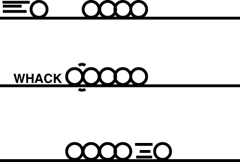

Push the Energy, Pull the Body
The first movements of the start, after the signal to go, should be the hands quickly pushing up from the platform (don't grab) and then the arms reaching up and out. This rapid acceleration of the arms creates a the force that will lift the body up off of the blocks.
As the arms come up the hands should be stretching out as though reaching for the backstroke flags above and out. As the fingers reach out the kinetic energy is pushed out front of the body and the rest of the body is pulled up into the air. This is why it is important to get into the streamline position immediately. Push the kinetic energy through your body.
Sonic Boom
Imagine a buggy-whip. The main "gimmick" is the taper of the diameter from the handle to the tip. When the whip is swung, the hand moves slowly, less than under 20 mph. A traveling wave moves into the "thick" part, and travels toward the "thin" part. The wave speeds up as it travels the length of the whip, because there is less mass to carry the same energy. When the wave reaches the tip, it is a tiny mass moving with the same energy as the hand was.
Since energy is proportional to the product of mass and speed, for a given input energy (from the hand) the lower the mass, the greater the speed. Done properly, a relatively small input at the hand can drive the tip faster then the speed of sound. The "crack" is a tiny "sonic boom".
|
Another PowerStartsTM Secret |
In a similar way, the accelerated motion of the arms reaching up-and-out sends a wave of motion from your ("thick") forearm, to your ('thin") finger tips. When the wave reaches the finger tip they are moving at tremendous speed.
To understand why this is more effective, consider a block of wood and a Tae Kwan Do athlete. If the martial artist hits the block of wood slowly, it would bend a little and push back, hard, or it would move away. But hit it fast, and the center part instantly starts to move, before the rest of the wood. The wood bends, but has no chance to push back or slow the motion. The block of wood breaks. The block of wood was not able to "bounce back the energy", like a trampoline. The wood nearest the hit was suddenly moving fast, and it bent too far before it could stop.
High-Speed Breaks. The wood actually "pulls apart" on the side opposite the hit. If the hit is snappy enough, the shock wave goes through the wood and knocks a piece out the other side. The rest breaks as usual.
Transfer of Momentum
Breaking Wood The secret to breaking wood and not the finger is that the hand does not penetrate the wood. Why? The impact begins before the hand touches the wood, and is cushioned by air that is trapped under pressure, forming a tiny cup-shaped depression in the finger tissue. The effect at the wood is to increase the impact.) This is called "transfer of momentum" and happens before the wood can move. The hand stops or bounces back, just as the wood begins to move.
Bullets Why is this different from a bullet? The bullet moves faster than sound. So the bullet moves into the wood before the shock wave can push the wood out of the way.
Billiards Here is the same thing on a billiards table. The billiards balls touch in a perfect straight line. The incoming ball stops dead. The three center balls never move.
